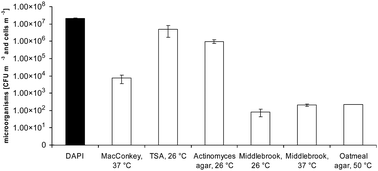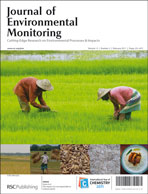Today's large-scale poultry production is often accompanied by high concentrations of airborne microorganisms at working places. However, the microbial communities in those bioaerosols are rarely characterised. In this study, we investigated the bacterial population in bioaerosols from a duck hatchery by both cultivation based and molecular methods and compared the results. Depending on used media, concentrations of airborne culturable bacteria varied between 6 × 101 and 7 × 106 CFU per m3 air. The corresponding total cell count of DAPI stained cells was 2 × 107 cells per m3 air. 16S rRNA gene analyses of bacterial isolates and clone libraries revealed a low species richness in hatcheries air, respectively. More than 50% of bacterial isolates were phylogenetically most closely related to bacterial species of the risk group 2 (German TRBA). The sequence composition in clone libraries supported the result of cultivation based approaches, whereby sequences assigned to Staphylococcus, Acinetobacter and Enterococcus are the most common. The high concentration of airborne bacteria which are most closely related to species of potential health risk requires further detailed investigations for these bacterial species.

You have access to this article
 Please wait while we load your content...
Something went wrong. Try again?
Please wait while we load your content...
Something went wrong. Try again?


 Please wait while we load your content...
Please wait while we load your content...